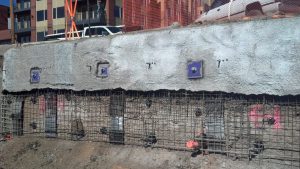
Last month, we discussed the cost-effectiveness of soil nailing as a slope stabilization solution. Now, let’s look at the most favorable conditions for applying this method. At Thorcon Shotcrete and Shoring, we design custom solutions to fit each project. From our headquarters in Littleton, Colorado, we have implemented soil nailing processes in many projects within our service area (which includes Denver, the rest of Colorado, as well as states in the surrounding region). For visual examples of soil nailing and our other methods, check out our gallery.
According to a report done for the Federal Highway Administration, soil nailing is most favorable (and cost-effective) under the following slope conditions:
- Preferably, all soil nails will be implemented above the groundwater table.
- Should any nails need to be below the water table, the conditions can still be favorable so long as the ground water doesn’t cause a problem with the bond strength of the grout, the excavation face, or the life of the nails, themselves.
- In ideal conditions, the slope receiving the soil nails can stay standing without support for 24-48 hours at a 3-6 foot vertical cut.
In addition, certain ground types are preferable for soil nailing. Slopes which are comprised of other types of soils require different methods of slope stabilization. The following are the most favorable ground types for soil nailing:
- Glacial soils
- Weathered rock (provided there are no problematic weakness planes)
- Stiff to hard cohesive soils
- Dense to very dense granular soils (preferably with a level of cohesion)
Our engineers will analyze your particular ground type and stabilization needs before determining if soil nailing is the right course of action for your project. Whichever slope stabilization or soil erosion control method we implement, our team always completes each project with the utmost attention to detail, safety and client satisfaction. Contact Thorcon today to get started!
